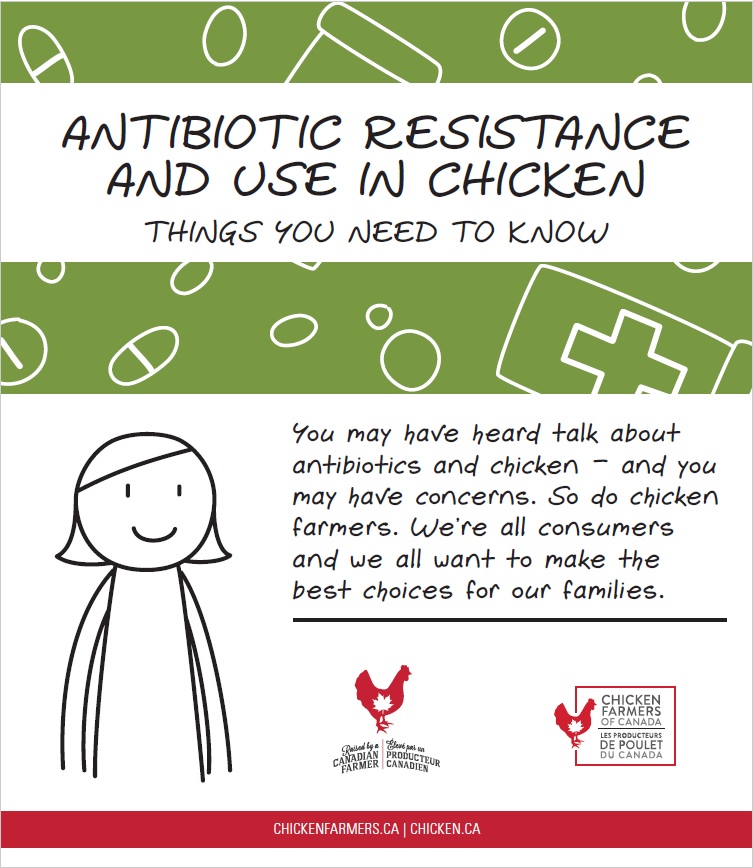


 Français
Français


Chicken Farmers of Canada (CFC) has actively engaged with stakeholders and has implemented a series of initiatives to demonstrate responsible antimicrobial use (AMU) in the Canadian chicken sector.
CFC’s Responsible AMU Strategy, launched in 2012, was developed in conjunction with the Canadian Hatchery Federation, Canadian Hatching Egg Producers, Canadian Poultry and Egg Processors Council, the Animal Nutrition Association of Canada, and the Canadian Association of Poultry Veterinarians.
Key Focus on Medically Important Antimicrobials
Antimicrobials are, and will remain, essential tools to protect the health and welfare of birds and to ensure a safe food supply. CFC supports the responsible use of antimicrobials that have been approved by the Veterinary Drugs Directorate of Health Canada. The objective of CFC’s strategy is to demonstrate proactive management of antimicrobial use and to reduce the use of antimicrobials of human importance in order to preserve effective treatment options.
The Canadian chicken industry has taken major steps in antibiotic reduction, with the removal of the preventive use of Category I antimicrobials in 2014, followed by the removal of Category II preventive use at the end of 2018. The effectiveness of these initiatives has been demonstrated by the government’s Canadian Integrated Program for Antimicrobial Resistance Surveillance (CIPARS) program. CIPARS has demonstrated an elimination of preventive use and has pointed to the chicken sector’s AMU strategy as a major factor for reduced antimicrobial resistance in targeted bacteria.
This strategy continues to allow for the use of antimicrobials to treat and control diseases, and for the use of ionophores and chemical coccidiostats. Maintaining the use of antibiotics for treatment is a critical cornerstone to CFC’s strategy to maintain animal welfare and food safety. While there are markets for “raised without the use of antibiotics” products, CFC does not believe this approach is sustainable for the entire industry. Antibiotics will continue to be essential for use in agriculture to maintain animal welfare, which is why CFC’s strategy focusses specifically on preventive use, rather than full elimination.
Building on the elimination of the preventive use of Category I and II, CFC is now focusing on a non-regulatory approach to further reducing antimicrobial use, with specific attention on reducing the preventive use of Category III antimicrobials.
The direction to focus on reducing the preventive use of Category III antimicrobials was taken following the re-assessment of the original goal to eliminate the preventive use of Category III antimicrobials by the end of 2020. The re-assessment process concluded that a mandatory regulatory requirement was not a responsible approach at this time.
Through the re-assessment process, CFC has reaffirmed its commitment to antimicrobial reduction and the CFC Responsible AMU Strategy.
Moving forward, CFC will be working with key supply chain stakeholders to promote reduction strategies, increase access to animal health products and share lessons-learned on reduction experiences.
This strategy, covering all chicken raised in Canada, works in collaboration with the federal government’s Pan-Canadian Framework on Antimicrobial Resistance and Antimicrobial Use, and is centered around the key guiding elements of surveillance, stewardship, and research.
Why do we have a strategy?
Any antimicrobial use – in humans or animals – can lead to resistance. The chicken industry needs to do its part in reducing usage, not only because it is the right thing to do but because our customers have demanded. CFC’s strategy is a clear demonstration of commitment to the issue of antimicrobial resistance and use, and provides continued confidence to customers, consumers and government about the sustainability of the Canadian chicken sector.
Talking to Consumers
Antimicrobial use in agriculture will continue to be important to manage disease, animal welfare and food safety. Therefore, open communication with consumers about the importance of these products is important. CFC has developed several tools to help consumers understand antimicrobial use. For instance, check out examples of brochures, a series of videos, and the letstalkchicken.ca website explaining antimicrobial use in the chicken sector.

The question is often asked why we can’t just assure consumers that there are no antibiotic residues in the meat. This is an important core message and much of our consumer communication clarifies that the issue of antimicrobial resistance is not the same as antimicrobial residues. As always, consumers can be assured that they are not eating the antibiotics that may have been given to the chickens. Canada has strict regulations about antibiotic usage (including ensuring that all Category I to III medications given to birds have a veterinary prescription), and the Canadian Food Inspection Agency monitors and inspects chicken to ensure there are no issues with antibiotic residues in the meat. However, as we explain in another article, the present-day concern is not about residues, it is about reducing resistance and that is why we need to have a responsible AMU strategy.